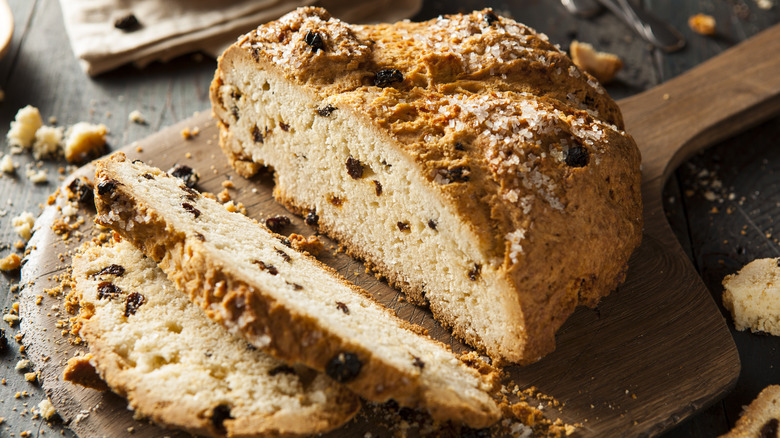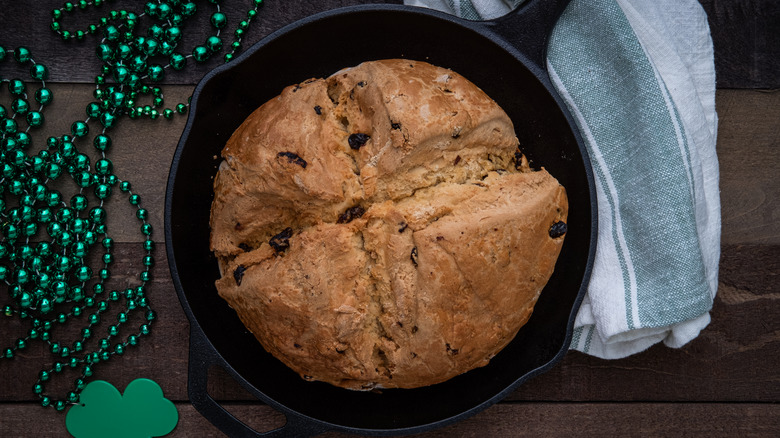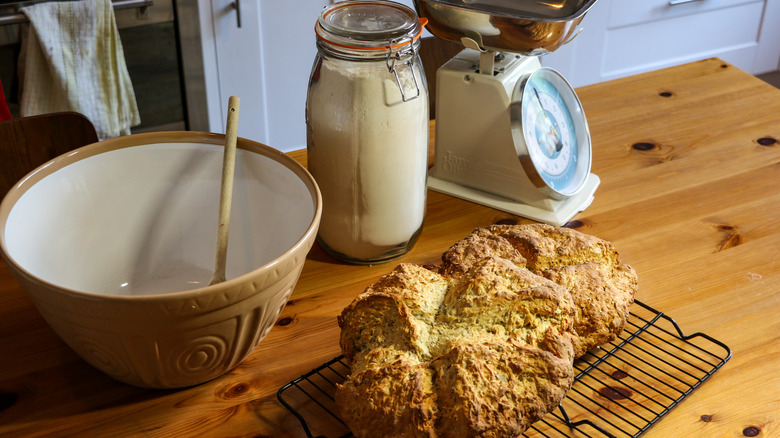The History Of Irish Soda Bread (And How To Eat It)
Bread may not be the first thing that comes to mind when you think of the Emerald Isle, but consider this — bread soda and baking soda were, at one point, interchangeable terms in the region. While Irish traditions like beer on St. Patrick's Day are loudly celebrated, the soft, crusty, wholesome soda bread is a lesser-known but equally iconic component. Now quintessentially Irish, its origin is rooted in a baking soda-driven bread-baking revolution in the region and subsequent growth in popularity fuelled by the devastating Irish Potato Famine.
What sets it apart is that soda bread swaps out yeast for the uncomplicated and faster-acting baking soda. An acidic ingredient (generally buttermilk, but hydrochloric acid was also used in the past) reacts with the alkaline soda to produce carbon dioxide, which is what makes the bread fluffy. This substitution also allows the bread to be baked over coals rather than in an oven, making it even more accessible.
Soda bread is a testament to simplicity and versatility. In contemporary kitchen terminology, it is a no-knead bread, and its buttermilk-moistened crumb goes well with everything from softened butter and fruit preserves to afternoon tea, aged cheeses, and hearty soups. This is a loaf even newbie bread-bakers can make in a jiffy and eat all day. Just remember to cut a cross on the dough before baking to cook the loaf's insides evenly and also to — as local lore goes — let the fairies out.
Irish soda bread originated during hard times in the 1800s
Dishes like Irish soda bread and the hearty Italian ribollita soup are intertwined with the countries' socioeconomic histories. Both dishes are products of trying times when a majority of the populace had to make do with what was available. However, wheat was not considered a big part of the Irish diet —as the abundance of starchy potatoes leading up to the famine made bread an unnecessary, even inconvenient option — until baking soda emerged as a cheaper alternative to yeast around the 1820s.
The first printed version of the Irish soda bread recipe dates back to an article from 1836 in Farmer's Magazine, sourced from an Irish newspaper called the Newry Telegraph. The recipe in the article calls for wheat flour, salt, bicarbonate soda, and "as much very sour buttermilk as will make the whole into a soft dough (it should be as soft as could possibly be handled, and the softer, the better)." It also expounds on the benefits of the bread, concluding that soda bread, "when somewhat cooled and moderately buttered, is as wholesome as ever entered man's stomach." The recipe and the reporter's description remain as accurate today as they were almost two centuries ago.
Homemade soda bread and how to eat it
Irish soda bread has a short shelf life and is best consumed the day it's baked. Fortunately, it only takes about an hour and four ingredients to make. Start by sifting together all-purpose or the more traditional whole wheat flour (skip the bread flour here), salt, and baking soda in a large mixing bowl, and gradually pour in buttermilk to create a wet dough. The proportions are flexible; you only need to be judicious with the baking soda since too much can impart an unpleasant, steely taste. As for the buttermilk, let it flow as long as you can handle the dough (remember the vintage recipe above).
No kneading is required; a quick mix to homogenize all the ingredients is enough. Once mixed, pour the soft dough into a Dutch oven and bake in a preheated oven for about 45 minutes, followed by briefly baking uncovered to give the bread a nice crust. To make the sweeter, more indulgent American version of soda bread, add eggs and butter, substitute the salt for sugar, and top the bread with raisins.
The first few slices should be paired with butter or honey to enjoy the bread's sweet tanginess and tender crumb. As the day progresses and it becomes firmer, soda bread becomes an excellent teatime snack. By the evening, soda bread is great for mopping up savory dinnertime stews and sauces, and it's highly unlikely you'll have any left the following day.


